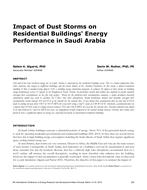Description
One-half of the total electrical energy use in Saudi Arabia is consumed by the residential building sector. This is a higher proportion than other countries, due largely to inefficient buildings and the harsh climate of the Arabian Peninsula. In this study, a typical residential building (Villa) is modeled using eQuest 3.65, a building energy simulation program, to estimate the impact of dust storms on building energy performance across 13 regions in the Kingdom of Saudi Arabia. In particular, hourly dust fallout was modeled to predict monthly averaged dust accumulation on the flat roof surface. Based on the predicted dust accumulation amounts, a newly developed transient absorptivity model was used to calculate the Villa’s roof solar absorptivity. Model predictions showed that monthly averaged dust accumulation varied between 8.0 and 81.6 g/m²/month for the selected sites. It was found that accumulated dust on cool roof (λ=0.2) leads to cooling increase from 110.3 to 181.9 kWh/m²/year with using a roof U-value of 2.84 W/m² K. Similarly, accumulated dust on a typical roof (λ=0.4) leads to cooling increase between 53.6 and 126.8 kWh/m²/year for the selected sites. Heating reduction was found to be only between 0.1 and 4.6 kWh/m²/year, an insignificant benefit compared to the annual cooling increase. Overall, dust storms were found to have a significant impact on energy use, especially for poorly or uninsulated residential buildings.
Citation: 6th International Conference on Energy Research and Development, State of Kuwait, March 14–16, 2016
Product Details
- Published:
- 2016
- Number of Pages:
- 8
- Units of Measure:
- Dual
- File Size:
- 1 file , 2.1 MB
- Product Code(s):
- D-ICER16-33




